Fri 6 Oct 2023
Nero Wolfe on Page and (Small U.S.) Screen: Three Witnesses, by Matthew R. Bradley.
Posted by Steve under Reviews , TV musicals[8] Comments
Three Witnessess
by Matthew R. Bradley
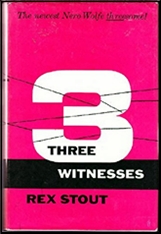
Rex Stout published one Nero Wolfe novel every year from 1946 (The Silent Speaker) to ’66 (Death of Doxy), and often a collection as well; the 1954 crop included, respectively, The Black Mountain and Three Men Out. Each novella first appeared in The American Magazine under a different title: “Invitation to Murder†(as “Will to Murder,†August 1953), “The Zero Clue†(as “Scared to Death,†December 1953), and “This Won’t Kill You†(as, oddly, “This Will Kill You,†September 1952). In “Invitation,†Archie lures Wolfe out of the house while trying to determine which of three women aspire to marry a wealthy widower in a wheelchair, and may have made him one with ptomaine poisoning.
“The Zero Clue†concerns the murder of a probability expert and former math professor, Leo Heller, whose penchant for complex formulae strongly recalls F.O. Savarese of And Be a Villain (1948). Justifying the collection’s sabermetric title, “This Won’t Kill You†opens with the unlikely spectacle of Wolfe acceding to the request by house guest Pierre Mondor — one of Les Quinze Maîtres, introduced in Too Many Cooks (1938) — to attend a baseball game at the Polo Grounds. The murder of a player, and drugging of four others, costs the Giants the seventh and deciding World Series contest against the Red Sox, with Wolfe hired by part-owner and oil millionaire Emil Chisholm, already deeply in his debt.
A pivotal entry, The Black Mountain builds on the events of Over My Dead Body (1940), and opens as Wolfe visits the morgue to see his boyhood friend Marko Vukcic, owner of Rusterman’s Restaurant, shot outside his home on East 54th Street. Widow Carla Britton (formerly Lovchen), Wolfe’s adopted daughter, believes agents of Belgrade or Moscow killed him for supporting rebels in their homeland of Montenegro (the Black Mountain), now part of Marshal Josip Broz Tito’s Yugoslavia. Sending weapons is against U.S. law, so her disappearance provokes a return visit from G-man Stahl, and after learning of her death in Montenegro from Paolo Telesio in Bari, Italy, Wolfe says he requires a passport.
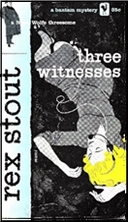
As we follow them to London (where Ethelbert Hitchcock is now Geoffrey), Rome, and across the Adriatic, Archie notes, “The basic setup between [us] was upset,†making him rely on Wolfe, as he knows the turf blindfolded, speaks eight languages, and translates as he can. Marko’s nephew, Danilo, is paid by both Titoists and Russians while guarding an arms cache for the Spirit of the Black Mountain, who may harbor a spy; in an old Roman fort, Archie avenges Carla, shooting Moscow’s Albanian puppets as they torture Marko’s killer, Peter Zov. In an impressive con job, Wolfe persuades his superior, Gospo Stritar, that they should bring him back to America for “safetyâ€â€¦then turns him over to Cramer.
In Before Midnight (1955), Wolfe is hired to find out not who shot Louis Dahlmann, but who took the answers in a million-dollar perfume contest from his body. The novellas in Three Witnesses (1956) also premiered in The American Magazine: “The Next Witness†(as “The Last Witness,†May 1955), “When a Man Murders…†(May 1954), and “Die Like a Dog†(as “The Body in the Hall,†December 1954). “When a Man Murders…†introduces Tim Evarts, described as the Hotel Churchill’s “first assistant security officer, not to be called a house dick,†in Before Midnight; we also learn that “Only two assistant district attorneys rate corner rooms, and [ADA Irving] Mandelbaum wasn’t one of them.â€
In “The Next Witness,†Archie sees him “perform in a courtroom†for the first time as he tries to convict theatrical producer Leonard Ashe for strangling stage-struck Marie Willis and questions employer Clyde Bagby, the president of answering service Bagby Answers Ink.
She reportedly refused to perform a “special service†eavesdropping on Ashe’s wife, ex-actress Robina Keane, and intended to warn her idol; subpoenaed to testify, Wolfe had turned down Ashe, who says he was summoned to Bagby’s office by an anonymous call, arriving to find her dead. On deck after Bagby, Wolfe risks a fine by taking Archie there to prevent a “justicial transgression†by refuting Mandelbaum’s thesis and clearing Ashe.
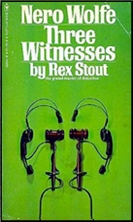
Wolfe seeks to question employees Helen Weltz — now off-duty — Alice Hart, and Bella Velardi, but new receptionist Pearl Fleming was not working there then. Alice, like Lily Rowan, owns a Van Gogh, allegedly bought with her savings; Bella claims she makes her race-track bets on behalf of friends, while Helen has a Jaguar and may have been Marie’s rival for the affections of Guy Unger. Bearding Helen in her Westchester summer rental, and now officially AWOL, they find Guy with her, but although Wolfe is convinced that the quartet is concealing something, Helen refuses to unload in the presence of Guy, who offers a retainer for undefined investigative services, and they head for Saul’s apartment.
Spotting Purley on his way in, they detour first to defense attorney Jimmy Donovan, who won’t get Wolfe in to see Ashe, and then to Keane, who will; Helen agrees to meet Wolfe chez Saul, the site of “friendly and ferocious poker†on Saturday nights, escorted there by Archie from Grand Central.
Cut to the courtroom the next morning when Wolfe takes the stand — placed under arrest and threat of a contempt charge by Judge Corbett. Questioned by Mandelbaum, he says Ashe tried to hire him to learn Marie’s identity and propose the eavesdropping, and relates their conversation just one hour ago, noting that an answering service could be a goldmine for a blackmailer, before he is cross-examined by Donovan.
“As a witness for the prosecution, with a warrant out for my arrest, I was in a difficult situation,†but this stratagem allows Wolfe to get “information which cast a reasonable doubt on his guilt…before the court and the jury…†He concluded that the suspiciously well-off operators had colluded in an eavesdropping conspiracy — as Helen confirmed — with Guy and Bagby, and that Marie became a threat when she’d refused their orders to accept Ashe’s proposal. Wolfe fingers Bagby as the killer; Corbett dismisses the charge of contempt; Ashe shows his appreciation with “a handsome check,†despite not being a formal client; and the case is solved in a narrative set completely outside the brownstone.
“Die Like a Dog†finds Archie trying to return a raincoat to Richard Meegan, who took his by mistake after Wolfe declined to take on a marital case, but arriving at his building, Archie sees Purley on the way in (again) and a black Labrador retriever that follows him, fetching his wind-blown hat. He mischievously brings “Nero†home, perhaps forgetting the rage displayed by Wolfe — who says he had a dog as a boy — at the injustice to Nobby from In the Best Families (1950). Archie’s call to trace his tag number elicits a visit from Cramer, revealing that owner Philip Kampf was strangled in that building, also occupied by lawyer Victor Talento, painter Ross Chaffee, and night-club performer Jerome Aland.
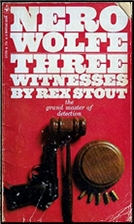
Arguing that Archie is obliged to see to his welfare, Wolfe refuses to let Cramer take Jet (as he calls him), whose leash was the murder weapon, to Arbor Street to see which door he goes to; to resolve the situation by solving the murder, he sends Archie back with the raincoat. Seeing Talento leaving, Archie tips him off that he’s being tailed by the police, and agrees to make excuses to singer Jewel Jones at their rendezvous in exchange for his pledge to see Wolfe the next morning.
She comes immediately, and is recognized by the dog (real name: Bootsy), having formerly lived in what is now Meegan’s apartment and been intimate with Kampf, but says they had no quarrel, and Talento is merely her friend.
Wolfe consents to Cramer’s experiment with dog expert Sgt. Loftus, provided Archie is present; Aland credits Bootsy’s dislike to a misunderstanding at a party chez Kampf, and Meegan claims never to have seen him, while Talento and especially Chaffee seem to be on good terms with Bootsy.
Willfully assumed to be a cop, Archie questions Aland, who got his job through Jewel, and Pittsburgh commercial photographer Meegan, who sought his estranged wife, Margaret Ryan. After seeing her depicted in Chaffee’s Three Young Mares at Pasture, he took the now-vacant apartment in the hope of locating her, since he disbelieved Chaffee’s claim that he couldn’t remember her among his numerous models.
On a hunch, Archie infiltrates the home of Chaffee’s frequent buyer Herman Braunstein, photographs the painting — which he’d recently lent to the Pittsburgh Art Institute — and confirms that Jewel is Mrs. Meegan.
Brought to the brownstone, she says she feared for her life due to Dick’s jealousy, and when Wolfe summons the tenants, the rest of whom concealed knowledge of her from Meegan, Cramer and Purley crash the party. Bootsy, it transpires, had followed not Archie but the coat, in reality Kampf’s; having inadvertently switched coats not once but twice, Meegan strangled Kampf (who’d threatened to expose Jewel if she did not resume their relationship), and unwittingly put Archie’s coat on him.
The second season of A&E’s A Nero Wolfe Mystery included the consecutive episodes “The Next Witness†(4/21/02) and “Die Like a Dog†(4/28/02), both directed by repertory player James Tolkan and adapted by the redoubtable Sharon Elizabeth Doyle. Shown internationally in a double-length version, “The Next Witness†upgrades Mandelbaum (Wayne Best) to D.A. and — unlike the novella— includes Cramer (Bill Smitrovich), who gleefully serves Wolfe (Maury Chaykin) and Archie (Timothy Hutton) personally. They arrive two hours late, eliciting sarcasm from Corbett (Beau Starr); the “Smelly Woman†(Carolyn Taylor) beside Wolfe, applying perfume, is the straw breaking the camel’s back.
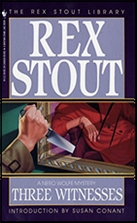
Bagby (Boyd Banks) circumvents labor-law restrictions by having his operators provide their 24-hour service while living and working in the same apartment, so Pearl (Kathryn Zenna) takes a board while Wolfe questions Alice (Nicky Guadagni) and Bella (Christine Brubaker) in their rooms. In Katonah, he notes that Helen (Francie Swift) is “on the edge of hysteria,†and as he confers privately with Guy (Richard Waugh), she breaks down in tears walking with Archie.
The latter declines to call Donovan (Robert Bockstael) — who as a sworn officer of the court would have to serve the warrants — and after leaving Keane (Rebecca Jenkins), they head for Saul (Conrad Dunn) with no sign of Purley (R.D. Reid).
In a scene taken straight from Stout, and expanded for the international version, first-time visitor Wolfe commends Saul for “A good room. Satisfactory. I congratulate you,†then feasts on beer, sturgeon, paté, pickled mushrooms, Tunisian melon, and three varieties of cheese.
Doyle depicts the start of the meeting at which he shares his theories with Ashe (David Schurmann), merely related in the novella on the stand. Under Donovan’s cross-examination, as Wolfe begins to unfold the story of the blackmail operation that included Marie (Brittney Banks) and was run by Alice, Archie’s timely warning to the guard stops her, Bella, and Guy from making a beeline to the exit once they realize that the jig is up…
Interestingly, while director Tolkan doubles as Loftus in “Die Like a Dog,†the episodes shared no repertory players (so defined, if you’re curious, as those appearing in three or more adaptations), who filled all other roles except the policeman played by Robbie Rox, also seen in “Cop Killer†(8/11/02).
As usual, Doyle dramatizes events just alluded to by Stout, e.g., Meegan (Bill MacDonald) grabbing the raincoat while leaving in a huff; when Archie returns, she retains his mention of Fritz’s turtle and Theodore’s parakeets, perhaps for the only time in the canon. Seeing Bootsy/Ebony/Inky/Jet/Nero (Jessie and Guinness) while announcing dinner, Fritz (Colin Fox) wryly asks, “Is the animal dining with you?â€
Kari Matchett — whose roles range from Wolfe’s adopted daughter to Archie’s recurring romantic interest, Lily Rowan — is properly seductive as Jewel, intercepted on behalf of Talento (Alex Poch-Goldin). After the experiment with Chaffee (Steve Cumyn), Aland (Julian Richings), and the others fails, Wolfe explains that Bootsy showed no interest in the spot where Kampf was found because he was clad in, first, Meegan’s coat, and then Archie’s.
Leaving the dog in care of a cabbie (Angelo Tsarouchas), Archie risks letting the tenants assume he is a cop, having been arrested for the same stunt in Prisoner’s Base (1952) by Lt. Rowcliff, aptly also played by MacDonald (suitably abrasive as Meegan).
In Wolfe’s office, the terrified Jewel says that Kampf “had to go see Dick again anyway, because Dick had gone off with his raincoat. Phil thought it was funny that Dick had his raincoat and he had Dick’s wife. I’ll bet that’s just what he told you, hunh?…that I was coming back to him, and he thought that was a good trade — a raincoat for a wife.†The novella, if not the episode, ends with the implication that Bootsy, who “responds to Jet now,†will remain in residence at the brownstone. But I will not be surprised if, like the aforementioned alleged pets or Felix’s “beloved†parrot in the Odd Couple episode “It’s All Over Now, Baby Bird†(12/3/70), Albert, he will never be seen or heard about again.
— Copyright © 2023 by Matthew R. Bradley.
Up next: Might as Well Be Dead
Editions cited —
Three Men Out, The Black Mountain: Bantam (1955)
Before Midnight: Bantam Crime Line (1993)
Three Witnesses: Bantam (1957)
Online sources —
October 6th, 2023 at 8:43 pm
Rex Stout is known for his novella length tales of Wolfe and Archie, and he seems to have been one of the few mystery writers who’ve been successful in writing in the short novel form.
Does anyone, Matthew?, have any idea why he used the short novel format as often as he did? My thought is that he must have *liked* writing at that length. I’ve not read enough of them to say, but I’ve always enjoyed the shorter works, and I think Stout had fun writing them.
I’ve just finished reading “Too Many Detectives<" and if any of you have read it recently, you'll know what I mean in saying that it's laugh out loud funny to read.
October 7th, 2023 at 8:05 am
Funny you should say that. At least in my idiosyncratic opinion, many a crime or mystery writer excelled in either the long or short form but not both. For example, sacrilegious though it may sound, my admittedly dim recollections of the Sherlock Holmes novels aren’t that good. But I’ve long felt that Stout was one of the few equally good at both, although I have no insight into his fondness for the novella format.
Three for the Chair, which contains “Too Many Detectives” (Wolfe’s introduction to Dol Bonner, IIRC), is on deck after Might as Well Be Dead. Can’t wait!
October 7th, 2023 at 1:57 pm
It feels like in the golden days of yore, young writers broke in to the biz writing short stories and novella length stuff suitable for publication in the pulps or the slicks. So they had to display ability in that mode merely to survive and get started. Then, if you were lucky, you might get commissioned to rewrite a story into novel length or publish serial stories like Red Harvest or Green Ice that could later be collected together as a ‘novel’.
Furthermore, nearly everything published by Black Lizard, for example, seems like novella length compared to standard crime novels published today where it seems like 500 pages is now de minimus (yet for me, 300 pages is de maximus). I cannot, for the life of me, understand why a simple crime story cannot be relayed in 200 pages or less. Unless you’re writing a multigenerational international saga from various class, ethic and gendered perspectives, I’d really appreciate it if writers would go back to the good old days of the hardboiled era where you were admired for succinctness rather than verbosity.
October 7th, 2023 at 9:22 pm
Novella length was perfect for the slicks that paid as much as most hardcovers for one. A Stout novella in one of the majors could bring in $1500 or more at a time a novel might bring in an advance of $500 to less than $1000. Time and money wisethey were a good bet and the reason you see so many novellas from that era.
Many writers of the period, Stout, Leslie Charteris, Kelly Roos, Ellery Queen, Philip Wylie… primarily wrote novellas for LIBERTY, AMERICAN MAGAZINE, and others. The slick market where John D. MacDonald first broke through in the fifties (he was a great favorite in COSMPOLITAN) paid better for originals than paperbacks did, plus serializations of his Gold Medal titles.
We talk about the pulps, but the slick market paid much better and many career writers of note specialized in them (it didn’t hurt that Hollywood read them and picked up stories from them either). Some famous pulp writers like Fred Nebel and Lester Dent didn’t disappear after the War, they switched to the slicks for better pay days. Television writer Roy Huggins came out of the slicks where he created Stu Bailey in several novellas.
Forgotten writers like Clarence Buddington Kelland spent much of their careers in the slicks.
Well into the Sixties a novel serialized in one of the few slicks printing fiction could pay almost as much as a novel sale.
October 8th, 2023 at 1:38 pm
I don’t remember my parents reading any magazines, but my grandparents living next door subscribed to Collier’s, the Sat. Evening Post, and The American Magazine. No pulps, but by that time, there weren’t all that many still around. When I visited, my favorite was The American Magazine, and the long mystery novellas they always featured fascinated me. I tried reading them but I suspect I was too young to understand what they were all about. I know I was. I may have been nine or ten. I remember the illustrations for the Nero Wolfe stories, though,and how he was pictured in them. Those are the likenesses that have stayed with me ever since. My introduction to grown up mystery fiction!
October 8th, 2023 at 6:59 am
Good point, Tony; even a Stout novel feels wafer-thin by today’s standards.
October 9th, 2023 at 11:01 am
Your “wafer-thin” comment caught my notice:
I was trying to straighten out my shelves (see under lost causes), and I came across my cache of Nero Wolfe books – many of them Bantam and Pyramid paperbacks from the mid-to-late ’60s (cover prices 50c to 60c).
You wanna talk about “wafer-thin”?
Most of the Wolfe books (and I’m talking about the novels now) usually top out at about 130 pages – small, closely printed type, fast-fading paper, paperbacks that could fit into ’60s era men’s pants pockets …
… Mind you, the hardcovers from that period were pretty compact in the same ways ..,
Anyway, this in its turn led me to check out some Christie, Queen, and Gardner PBs from that same period … and most of them are pretty slim, too.
Some time back, it occurred to me to compare my old PBs to newer reissues from the past few years: the newer books have all the latest improvements – larger type faces, more white space, way easier to read (especially as i get older) – and have you noticed that the newer books are physically larger than the same books from the earlier time?
The mystery writers that so many of us grew up with weren’t writing sagas or epics – they were telling stories: mainly short and to the point.
“Today’s standards” led to the expansion (or inflation, if you like) of modern literature, to the doorstops of today; whether that’s better of not … well, we all have our own tastes …
October 9th, 2023 at 5:36 pm
Right now I’m reading THE CASE OF QUEENLY CONTESTANT, a Perry Mason mystery from 1968. It’s only 179 pages long. The print is small but I can still read it. Maybe half an inch thick, no more than that. Wouldn’t keep any door open. The price? Sixty cents. That’s not coming back, either.